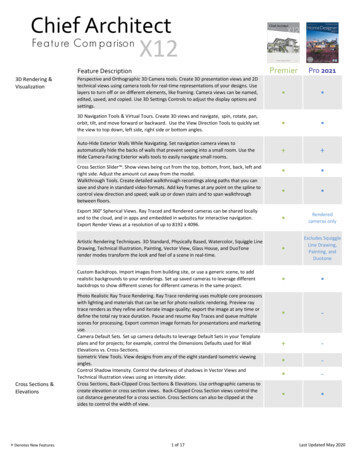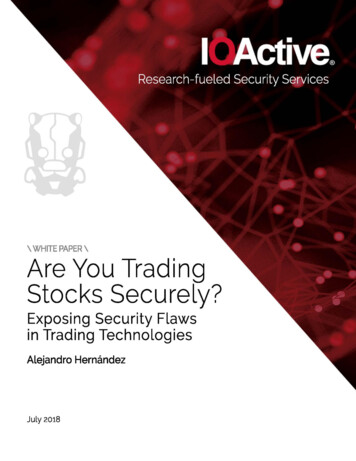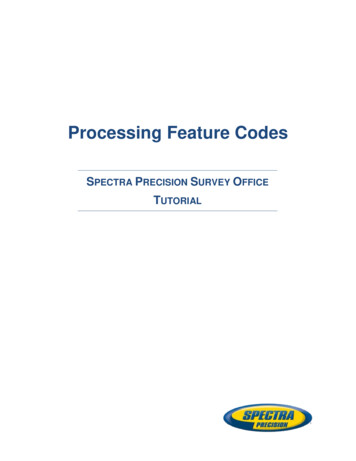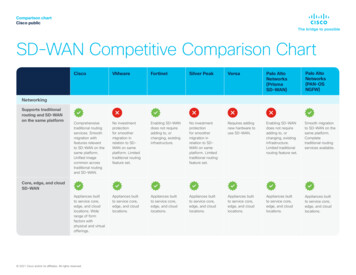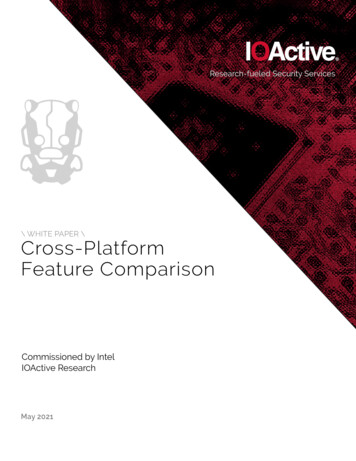
Transcription
Research-fueled Security Services\ WHITE PAPER \Cross-PlatformFeature ComparisonCommissioned by IntelIOActive ResearchMay 2021
ContentsAbstract. 5Disclosure . 5Management Summary . 6Technical Summary. 7Model and Comparison . 7Below the OS (Platform Integrity) . 7Platform Update . 8Trusted Execution/Application and OS Protection . 10Advanced Threat Protection . 10Crypto Extension . 11Intel Technologies . 13Intel Virtualization Technology . 13Intel Virtualization Technology for Directed I/O . 13Intel APIC Virtualization Technology . 14Intel Trusted Execution Technology . 15Intel Runtime BIOS Resilience . 16Intel System Resources Defense . 16Intel System Security Report . 17Intel Advanced Encryption Standard New Instructions (Intel AES-NI) and PCLMULQDQ. 17Intel Secure Key . 17Intel Boot Guard Technology. 18Intel Supervisor Mode Execution Protection . 18Intel Supervisor Mode Access Protection . 18User Mode Instruction Prevention . 19Intel Total Memory Encryption (Intel TME) . 19Intel Control-flow Enforcement Technology (Intel CET) . 20Shadow Stack . 20Indirect Branch Tracking . 20KeyLocker Technology . 20AMD Technologies . 21AMD Secure Processor Technology . 21AMD Secure RNG Library . 21AMD Virtualization Technology . 21Secure Virtual Machine . 21Secure Encrypted Virtualization. 22[2] 2021 IOActive, Inc. All Rights Reserved.
Secure Memory Encryption. 23Nested Virtualization . 23Encrypted State . 24Advanced Virtual Interrupt Controller . 24Secure Boot/SKINIT . 24Secure Loader . 24AMD SMM Supervisor . 25Shadow Stacks . 25Supervisor Shadow Stack . 25Guest Mode Execute Trap Extension . 26External Access Protection . 26I/O Memory Management Unit . 26AMD SMM Supervisor . 27Detailed Features Comparison . 28Hardware-assisted AES Instruction Set . 28AES Encryption . 28AES Decryption . 28AES Inverse Mix Column Transformation . 28AES Create Round Keys with Key Expansion Schedule . 29Cryptographically Secure Random Number Generator . 29Cryptographically Secure Deterministic Random Bit Generator . 29Cryptographically Secure Enhanced Non-Deterministic Random Bit Generator . 29Intel Virtualization Technology (Intel VT-x) vs. AMD-V. 29Intel VT-d vs AMD-Vi (IOMMU) . 30Discrepancy in Kernel DMA protection . 31Intel APICv vs AMD AVIC . 32Intel TXT vs AMD SKINIT . 32SMM Defense Technologies . 33Platform Differentiation . 34Considerations . 35Intel TME vs AMD SEV/SME . 35Intel CET . 37Intel KeyLocker Technology . 38Intel TDT . 38Intel Threat Detection Technology Tests . 40System Specification . 4010th Gen Intel Core vPro processors . 40[3] 2021 IOActive, Inc. All Rights Reserved.
11th Gen Intel Core vPro mobile processors . 40AMD . 41Test Artifacts . 42Cryptominer Binaries. 42Obfuscated Cryptominer Binaries . 42Cryptominer Configs . 43Cryptominer Samples. 44Obfuscated Cryptominer Samples . 44Ransomware Samples . 45Obfuscated Ransomware Samples . 46Test 1. Cryptomining in VM: 10th Gen Intel Core vPro processors with Intel TDT vs AMD . 47Test 2a. Cryptomining on Host: 10th Gen Intel Core vPro processors with Intel TDT. 49Test 2b. Ransomware on Host: Intel CML with Intel TDT . 52Test 3a Cryptomining on Host: Intel TDT vs. Current AV . 53Test 3b. Ransomware on Host: Intel TDT vs. Current AV . 53Test 4. CML: Alternative to Test 3a and Test 3b . 54Test 5. . 54Test 6. . 54Addendum: Ryzen Pro 5000 Series Comparison . 55Management Summary . 55Intel vs AMD . 55Technical Summary . 56Model and Comparison . 56Below the OS (Platform Integrity) . 56Platform Update . 57Trusted Execution/Application and OS Protection . 58Advanced Threat Protection . 59Crypto Extension . 59Appendix A: References . 61[4] 2021 IOActive, Inc. All Rights Reserved.
AbstractFor an Intel-commissioned study, IOActive compared security-related technologiesfrom both 11th Gen Intel Core vPro mobile processors and AMD Ryzen PRO 4000series mobile processors. Our comparison was based on a set of objectives bundledinto five categories: Below the OS, Platform Update, Trusted Execution, AdvancedThreat Protection, and Crypto Extension.Based on our research, we conclude that AMD offers no corresponding technologiesin the Below the OS, Platform Update, Advanced Threat Protection, or CryptoExtension categories, while Intel offers features in all of these categories. Intel andAMD have equivalent capabilities in the Trusted Execution category.DisclosureThe research presented in this white paper was funded in part by Intel Corporation.[5] 2021 IOActive, Inc. All Rights Reserved.
Management SummaryIn this document, IOActive presents: A comparison of security features provided by the 11th Gen Intel Core vPro mobileprocessors and AMD’s Ryzen PRO 4000 series mobile processors, as well ashighlights from current academic research where applicable Test results of selected tests cases for Intel’s technologyIOActive has compared security related technologies from both Intel and AMD using the 11thGen Intel Core vPro mobile processors and Ryzen PRO 4000 series mobile (AMD) CPUs.Our comparison is based on a set of objectives bundled into five categories: Below the OS,Platform Update, Trusted Execution, Advanced Threat Protection (ATP), and CryptoExtension.From our research, we conclude that AMD offers no technologies in the ATP or PlatformUpdate categories. Intel offers BIOS Guard, Firmware Update Restart, Intel Control-flowEnforcement Technology (Intel CET), and Intel Threat Detection Technology (Intel TDT) inthe ATP category. In the Below the OS category, AMD has no corresponding technology toIntel System Security Report. In the Crypto Extension category, AMD has no correspondingtechnology to Intel’s AVX512-variant of AES. Based on our research, Intel and AMD haveequivalent capabilities in the Trusted Execution category.The following technologies are the most impactful platform differentiators for security:1. Intel CET2. Intel TDTAdditionally, the composites of the security technologies discussed in this document offer acompounded value that is greater than the sum of the parts.Our research team ran a series of tests for Intel TDT, based on install and executableinstructions provided by the Intel TDT team. The tests aimed to detect a curated selection ofsamples of cryptominers and known ransomware in various environments and on differentplatforms.The test results show a detection rate of 100% for ransomware and 100% for cryptominers byIntel TDT. Also, to better mimic threats that are increasingly obfuscating in virtual machines(VMs), we ran comparisons to popular anti-virus (AV) software that is not enabled for CPUbased threat detection. In these cases, Intel TDT was able to detect 75% of obfuscatedcryptominers, compared to 0% by AV software, which has a lack of visibility into these typesof attacks due to its typical deployment in the host OS. Note: Intel TDT is not a standaloneAV or EDR package; it is intended to integrate into these solutions to augment and improvethreat detection efficacy.[6] 2021 IOActive, Inc. All Rights Reserved.
Technical SummaryThe Intel Technologies and AMD Technologies sections of this document quote from publiclyavailable documents of both vendors and list particular security technologies. The DetailedFeatures Comparison section explains the commonalities and differences of thecorresponding technologies from both vendors. IOActive developed a security feature modeland used it to compare the two subject platforms as described in the Model and Comparisonsubsection.The Intel Threat Detection Technology Tests section contains a detailed description of thesetup for the tests for Intel TDT, the particular samples of ransomware and cryptominers thatwere used as test cases for the various tests, and the test results.Model and ComparisonIOActive’s approach for a comparison of features across vendor platforms started with theformulation of a security model. Our model consists of a carefully selected list of securityobjectives, bundled into categories. The objectives define goals and properties that providesecurity benefits to the customer. The categories relate to different execution stages of theCPU.The following paragraphs define the categories and their objectives, list technologies orbuilding blocks which can be used to achieve the objectives, and compare the correspondingtechnologies implemented by Intel and AMD.The model we present here is not exhaustive. It is missing a complete inventory of use-casesand would benefit from a thorough threat model of the security features. IOActive adapted anorganizational structure of objectives provided by Intel to create this model.Each compared feature is presented as fulfilling, fulfilling with qualifications, or not fulfillingthe associated objective.Below the OS (Platform Integrity)With the beginning of the boot sequence, the CPU must evaluate its hardware and firmwareenvironment and ensure transition only to a verified bootloader. This integrity validationmitigates the risk of instruction tampering or interception by an adversary as well as providinga trustworthy baseline for the remainder of boot and operation.In particular, the objectives include: Identify unauthorized changes to hardware and firmware Prevent malicious code injection in BIOS/UEFI memory Ensure OS and virtual environments are running directly on platform hardware(assuming no malicious code injection) Enforce OEM/IHV’s provided policy and report on itThe main building blocks to achieve these objectives include:[7] 2021 IOActive, Inc. All Rights Reserved.
Secure Boot Root of trust/chain of trust EnforcementMeasured Boot Secure storage Static root of trust measurement Dynamic root of trust measurement AttestationTable 1. Below the OS solutionsIntel SolutionAMD SolutionIntel Boot GuardAMD Secure BootIntel Trusted Execution TechnologyAMD SKINIT Secure LoaderIntel Runtime BIOS ResilienceAMD SMM Supervisor1Intel System Security ReportNo equivalent featureIntel System Resources DefenseAMD SMM Supervisor1Platform UpdateThis category is about mechanisms for trustworthy firmware updates. Each of theseprotections addresses the risk of replacement of some or all of the platform-defining softwareand firmware with malicious components. Objectives Update firmware code with integrity check Downgrade protection Focus on BIOS for most recent and secure updatesBuilding Blocks Provide new environment so OEMs can perform more flexible and modularupdates securelyUtilizes UEFI capsule architecture for driving better firmware updatesAs of publication, only a brief high-level description of this feature was available. The authors are provisionallyaccepting the assertions in this description.1[8] 2021 IOActive, Inc. All Rights Reserved.
Table 2. Platform Update solutionsIntel SolutionAMD SolutionIntel Firmware GuardNo equivalent feature2Intel BIOS GuardNo equivalent /guardmi-infographic.pdf equates AMD secure boot to both of these Intelfeatures, but this is not substantiated by public documentation, such pdf2[9] 2021 IOActive, Inc. All Rights Reserved.
Trusted Execution/Application and OS ProtectionThis category includes objectives for protection and prevention mechanisms to ensure atrustworthy runtime environment. Building on the integrity measures above, these elementsenhance the stability and safety of the platform’s operation. Objectives Prevent memory corruption and tampering attacks Protect sensitive data from unauthorized access Protect data and virtualized containers with hardware-enforced isolation andencryptionImprove performance of virtualized security workloadsBuilding Blocks/Hypervisor Support Virtualization instructions VM extensions Nested virtualization Virtual I/O Virtual interrupts Memory protection/encryption Hardware-based encryption and random number generationTable 3. Trusted Execution solutionsIntel SolutionAMD SolutionIntel Virtualization Extensions (VT-x)AMD-VIntel Virtualization Technology for DirectedI/O (VT-d)AMD-ViIntel APIC VirtualizationAdvanced Virtual Interrupt Controller (AVIC)Intel Mode Based Execution ControlAMD-V with GMETIntel Control-flow Enforcement TechnologyNot implemented in Ryzen PRO 4000Intel Total Memory EncryptionAMD SEV/SME3Advanced Threat ProtectionThe objectives in this category do not protect or prevent attacks facilitate their detection.3As of Ryzen 4000 Pro Series. 5000 Pro Series adds additional capabilities.[10] 2021 IOActive, Inc. All Rights Reserved.
Objectives Increase security and performance via offload to GPU dedicated securityworkloadsLeverage hardware telemetry to help detect advanced threats such as ransomwareand cryptomining attacksBuilding Blocks Reference code components DetectorsTable 4. ATP solutionsIntel SolutionAMD SolutionIntel TDT- Security Offload to iGPU (e.g.,Memory Scanning)No equivalent featureIntel TDT - Advanced Platform TelemetryNo equivalent featureCrypto ExtensionThis category lists objectives for hardware support for crypto primitives with specificproperties. Objectives Provide hardware implementations for certified crypto primitives Mitigate side channels in the implementation of crypto primitives Allow crypto operations without storing key where it can get lost High speed and throughputBuilding Blocks Good source of randomness (rdrand) Efficient crypto primitives with side channel mitigation Secure key storage (TPM, PKEY) Parallelizable implementation of primitives Hardware-assisted AES encryption Hardware-assisted AES decryption Hardware-assisted AES inverse mix column transformation Hardware-assisted AES created round keys with key expansion schedule Cryptographically secure enhanced non-deterministic random bit generator Cryptographically secure deterministic random bit generator[11] 2021 IOActive, Inc. All Rights Reserved.
Table 5. Crypto Extension solutionsIntel SolutionAMD SolutionIntel Advanced Encryption Standard NewInstructions (Intel AES-NI)AMD AES-NIIntel Secure KeyAMD RNRANDKey LockerNo equivalent feature[12] 2021 IOActive, Inc. All Rights Reserved.
Intel TechnologiesThe following sections contain the description of technologies from Intel, based on publiclyaccessible documentation. The quotes in these sections are primarily from Intel document ID631121 version 003.4Intel Virtualization TechnologyIntel Virtualization Technology (Intel VT) makes a single system appear as multipleindependent systems to software. This allows multiple, independent OSs to runsimultaneously on a single system. Intel VT comprises technology components to supportVirtualization of platforms based on Intel architecture microprocessors and chipsetsIntel VT, Intel 64, and Intel architecture (Intel VT-x) added hardware support in the processorto improve the virtualization performance and robustness. Intel VT for Directed I/O (VT-d)extends Intel VT-x by adding hardware-assisted support to improve I/O device virtualizationperformance.Intel VT-x provides hardware acceleration for virtualization of IA platforms. VM Monitor (VMM)can use Intel VT-x features to provide an improved reliable virtualization platform.The processor supports the following added new Intel VT-x features: Mode-based Execute Control for EPT (MBEC): A mode of EPT operation whichenables different controls for executability of Guest Physical Address (GPA) based onGuest specified mode (User/Supervisor) of linear address translating to the GPA.When the mode is enabled, the executability of a GPA is defined by two bits in EPTentry. One bit for accesses to user pages and other one for accesses to supervisorpages.Intel Virtualization Technology for Directed I/OThe key Intel Virtualization Technology for Directed I/O (Intel VT-d) objectives are domainbased isolation and hardware-based virtualization. A domain can be abstractly defined as anisolated environment in a platform to which a subset of host physical memory is allocated.Intel VT-d provides accelerated I/O performance for a virtualization platform and providessoftware with the following capabilities:4 I/O Device Assignment and Security: for flexibly assigning I/O devices to VMs andextending the protection and isolation properties of VMs for I/O operations. DMA Remapping: for supporting independent address translations for Direct MemoryAccesses (DMA) from 631121[13] 2021 IOActive, Inc. All Rights Reserved.
Interrupt Remapping: for supporting isolation and routing of interrupts from devicesand external interrupt controllers to appropriate VMs. Reliability: for recording and reporting to system software DMA and interrupt errorsthat may otherwise corrupt memory or impact VM isolation.Intel VT-d accomplishes address translation by associating transaction from a given I/Odevice to a translation table associated with the Guest to which the device is assigned. It doesthis by means of the data structure in the following illustration. This table creates anassociation between the device's PCI Express Bus/Device/Function (B/D/F) number and thebase address of a translation table. This data structure is populated by a VMM to map devicesto translation tables in accordance with the device assignment restrictions above and toinclude a multi-level translation table (VT-d Table) that contains guest-specific addresstranslations.Intel APIC Virtualization TechnologyAdvanced Programmable Interrupt Controller Virtualization (APICv) is a collection of featuresthat can be used to support the virtualization of interrupts and the APIC.[14] 2021 IOActive, Inc. All Rights Reserved.
When APICv is enabled, the processor emulates many accesses to the APIC, tracks thestate of the virtual APIC, and delivers virtual interrupts—all in VMX non-root operation withouta VM exit.The following are the VM-execution controls relevant to APICv and virtual interrupts: Virtual-interrupt Delivery: This controls enable the evaluation and delivery of pendingvirtual interrupts. It also enables the emulation of writes (memory-mapped or MSRbased, as enabled) to the APIC registers that control interrupt prioritization. Use TPR Shadow: This control enables emulation of accesses to the APIC’s taskpriority register (TPR) via CR8 and, if enabled, via the memory-mapped or MSR-basedinterfaces. Virtualize APIC Accesses: This control enables virtualization of memory-mappedaccesses to the APIC by causing VM exits on accesses to a VMM-specified APICaccess page. Some of the other controls, if set, may cause some of these accesses tobe emulated rather than causing VM exits. Virtualize x2APIC Mode: This control enables virtualization of MSR-based accessesto the APIC. APIC-register Virtualization: This control allows memory-mapped and MSR-basedreads of most APIC registers (as enabled) by satisfying them from the virtual-APICpage. It directs memory-mapped writes to the APIC-access page to the virtual-APICpage, following them by VM exits for VMM emulation.Intel Trusted Execution TechnologyIntel Trusted Execution Technology (Intel TXT) defines platform-level enhancements thatprovide the building blocks for creating trusted platforms.The Intel TXT platform helps to provide the authenticity of the controlling environment suchthat those wishing to rely on the platform can make an appropriate trust decision. The IntelTXT platform determines the identity of the controlling environment by accurately measuringand verifying the controlling software.Another aspect of the trust decision is the ability of the platform to resist attempts to changethe controlling environment. The Intel TXT platform will resist attempts by software processesto change the controlling environment or bypass the bounds set by the controllingenvironment.Intel TXT is a set of extensions designed to provide a measured and controlled launch ofsystem software that will then establish a protected environment for itself and any additionalsoftware that it may execute.These extensions enhance two areas: The launching of the Measured Launched Environment (MLE) The protection of the MLE from potential corruption[15] 2021 IOActive, Inc. All Rights Reserved.
The enhanced platform provides these launch and control interfaces using Safer ModeExtensions (SMX).The SMX interface includes the following functions: Measured/Verified launch of the MLE Mechanisms to ensure the above measurement is protected and stored in a securelocation Protection mechanisms that allow the MLE to control attempts to modify itselfFor the above features, BIOS should test the associated capability bit before attempting toaccess any of the above registers.As called out by security researchers Joanna Rutkowska and Rafal Wojtczuk in 2008-2009,“TXT is essentially useless without protection against SMM-originating attacks.”5 At the timethis was considered a contro
Intel Virtualization Extensions (VT-x) AMD-V Intel Virtualization Technology for Directed I/O (VT-d) AMD-Vi Intel APIC Virtualization Advanced Virtual Interrupt Controller (AVIC) Intel Mode Based Execution Control AMD-V with GMET Intel Control-flow Enforcement Technology Not implemented in Ryzen PRO 4000


